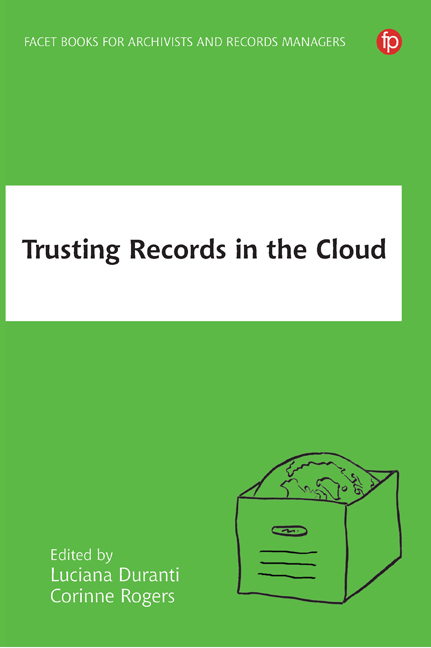Book contents
- Frontmatter
- Contents
- List of Figures and Tables
- Contributors
- 1 Introduction
- 2 The Cloud – Challenges and Issues
- 3 Open Government
- 4 Citizen Engagement
- 5 Strategies, Methods and Tools Enabling Records Governance in a Cloud Environment
- 6 Retention and Disposition
- 7 Authentication
- 8 Intellectual Control
- 9 Exploring Digital Preservation in the Cloud
- 10 Cultural Heritage – Indigenous Perspectives
- 11 The Role of the Records Professional
- 12 Education
- Appendix 1 InterPARES Trust Terminology
- Appendix 2 Products of InterPARES Trust Research
- Index
2 - The Cloud – Challenges and Issues
Published online by Cambridge University Press: 24 September 2019
- Frontmatter
- Contents
- List of Figures and Tables
- Contributors
- 1 Introduction
- 2 The Cloud – Challenges and Issues
- 3 Open Government
- 4 Citizen Engagement
- 5 Strategies, Methods and Tools Enabling Records Governance in a Cloud Environment
- 6 Retention and Disposition
- 7 Authentication
- 8 Intellectual Control
- 9 Exploring Digital Preservation in the Cloud
- 10 Cultural Heritage – Indigenous Perspectives
- 11 The Role of the Records Professional
- 12 Education
- Appendix 1 InterPARES Trust Terminology
- Appendix 2 Products of InterPARES Trust Research
- Index
Summary
Introduction
This scene-setting chapter provides an overview of the range of challenges and issues relating to trust and digital records in the cloud. A high-level framework is used as a vehicle for considering those that emerged from the work of the InterPARES Trust undertaken across the range of domains referred to in Chapter 1. Some of the challenges and issues are sufficiently significant and bounded that they are covered in subsequent chapters in their own right, while others feature in a number of chapters or are largely addressed in this chapter (e.g. security, policy models, cloud contracts, legal issues, roles and responsibilities).
Beginning with a brief introduction to cloud computing, including its nature, services and some associated legal issues, the framework is then introduced, followed by a discussion of each thematic group of challenges and issues with reference to further detail in other chapters or other publications. Issues of trust, including perceptions of trust, run throughout the book.
Cloud computing: an introduction
The ‘cloud’ is understood in the context of this research as a broad range of infrastructures and services distributed across a network (typically the internet) that are scalable on demand and that are designed to support management of high volumes of digital materials. Because ‘cloud’ – as a general term – is used in so many contexts and implemented in a variety of ways, its meaning is so broad that it is exceptionally nebulous. To the extent the term has been appropriated by marketing, a specific technical definition may be lost in hype. Often it connotes outsourcing some or all aspects of an organization's information technology services. (Pearce-Moses, 2018, s.v. cloud).
As with many developments, the origins of cloud computing have been credited to various individuals. The computer scientist John McCarthy is thought to have been the first to suggest the concept of using computer timesharing or ‘utility computing’ in the late 1950s/early 1960s (Wikipedia, 2018). The term ‘cloud computing’ is thought to have been used by staff at the Compaq computer company in the late 1960s, with Professor Ramnath Chellappa, at the University of Texas, being the first person to use it more publicly in a 1997 lecture (Madhavaiah, Bashir and Shafi, 2012; Mishra, 2014). However, staff at Oracle are also credited with its development (Bort, 2012).
- Type
- Chapter
- Information
- Trusting Records and Data in the Cloud , pp. 13 - 36Publisher: FacetPrint publication year: 2018



